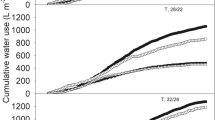Abstract
The recent elevation and predicted future rise in atmospheric carbon dioxide concentrations has led to greater interest in the effects of higher carbon dioxide concentrations on crop plants. Whilst there is a relatively large amount of information on the effects of increased carbon dioxide concentration on arable and glasshouse crops, relatively little is known about the responses of cool temperature forage crops to greater carbon dioxide concentrations. One of the most important forage crops is Lolium whose responses to higher carbon dioxide concentration have been de scribed at the whole crop level (Nijs, Impens & Behaeghe 1988, 1989; Hardacre, Lang & Christeller 1986). However, there is little information on the physiology behind the observed crop re sponses, particularly on how the plant acclimates to higher carbon dioxide concentrations. Thus we determined the effect of increased carbon dioxide and transfers from ‘ambient’ to ‘high’ carbon dioxide concentrations on growth and some physiological characters of Lolium temulentum.
Access this chapter
Tax calculation will be finalised at checkout
Purchases are for personal use only
Similar content being viewed by others
References
Hardacre, A. K., Laing, W. A. & Christeller, T. 1986. The response of simulated swards of perennial ryegrass and white clover to enriched atmospheric CO2: interaction with nitrogen and photo synthetic photon flux density. New Z. J. of Agr. Res. 29: 567–573.
Nijs, I., Impens, I. & Behaeghe, T. 1988. Effects of Rising Atmospheric Carbon Dioxide Concentration on Gas Exchange and Growth of Perennial Ryegrass. Photosynthetica 22: 44–50.
Nijs, I., Impens, I. & Behaeghe, T. 1989. Leaf and canopy responses of Lolium perenne to long term elevated atmospheric carbon-dioxide concentration. Planta 177: 312–320.
Pollock, C. J. 1982. Patterns of turnover of fructans in leaves of Dactylis glomerata L. New Phytol. 90: 645–650.
Ross, G. J. S. 1987. Maximum Likelihood Program release 3.08. Numerical Algorithms Group, Oxford.
Woodward, F. I. & Bazzaz, F. A. 1988. The responses of stomatal density to CO2 partial pressure. J. of Exp. Bot. 39: 1771–1781.
Author information
Authors and Affiliations
Editor information
Rights and permissions
Copyright information
© 1993 Springer Science+Business Media Dordrecht
About this chapter
Cite this chapter
Gay, A.P., Hauck, B. (1993). Acclimation of Lolium temulentum to enhanced carbon dioxide. In: Rozema, J., Lambers, H., Van de Geijn, S.C., Cambridge, M.L. (eds) CO2 and biosphere. Advances in vegetation science, vol 14. Springer, Dordrecht. https://doi.org/10.1007/978-94-011-1797-5_36
Download citation
DOI: https://doi.org/10.1007/978-94-011-1797-5_36
Publisher Name: Springer, Dordrecht
Print ISBN: 978-94-010-4791-3
Online ISBN: 978-94-011-1797-5
eBook Packages: Springer Book Archive




